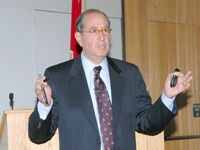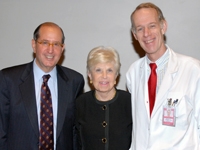The death rates from tuberculosis in the United States dropped so drastically between 1900 and 1960 that the disease was on the verge of extinction. And that sharp decline began decades before chemotherapy was introduced as an effective medical course for TB patients.

Dr. Alfred Sommer delivers his lecture, "America's Health: A Global Perspective," at the inaugural Kean Lecture in Global Health, Nov. 1.
So, if the disease was being effectively beaten back prior to any medical revelation, what sparked the decrease?
"What changed was better housing, better clothing, better nutrition and the separation of infected patients from healthy people," said Dr. Alfred Sommer, professor and dean emeritus at the Johns Hopkins Bloomberg School of Public Health. "It had nothing to do with medicine."
Dr. Sommer recently spoke at the inaugural B.H. Kean Lecture in Global Health at Uris Auditorium, discussing the varied influences - biological, social, community and economic - that can exercise a greater impact on public health than medicine alone.
Take, for instance, the Pima Indians. Already susceptible to obesity and type 2 diabetes because of genetics, Dr. Sommer noted a study finding that members of the Pima tribe living on the Arizona side the U.S.-Mexico border had an average body mass index of 37, considered morbidly obese. Pima situated on the Mexican side, however, had a normal BMI of 23.
"The only difference between these two groups is where they lived," Dr. Sommer said.
Geographic location and environmental issues have always had a significant impact on public health. A person emigrating from Japan to the United States, for instance, will likely experience a decreased risk of gastric cancer but a greater risk of heart disease. A relatively simplistic issue such as quitting smoking to reduce the likelihood of lung cancer becomes muddled because of the difficulty in just removing smoking from the equation.
"There are too many vested business interests in tobacco," said Dr. Sommer, who also noted that the Japanese government owns about 60 percent of that nation's tobacco industry.
And while breast cancer mortality rates have remained largely unchanged from 1900 to 1990, lung cancer mortality rates have risen sharply in that same period, to the point where more women in this country die from lung cancer than breast cancer.

Dr. Sommer (left) with Collette Kean and Dr. Henry Murray, associate chairman of clinical research in the Department of Medicine.
"We could stop future cases of lung cancer simply by stopping women from smoking," Dr. Sommer said. "But women don't see smoking as a women's issue. They're not running for the cure."
Dr. Sommer also pointed out early smallpox vaccination efforts, which were almost thwarted when the amount of vaccine began to deplete. It was the invention of the bifurcated needle - not a medicinal innovation - which prevented a shortage, as the new needle required a fifth less dosage of vaccine per patient, quintupling the amount of available vaccine.
To have a viable chance of influencing the non-medical factors on improving public health, Dr. Sommer stressed a five-pronged method of education, legislation, litigation, regulation and taxation.
"Education cannot change this alone," he said.
The lecture series is named for Dr. B.H. Kean, a Weill Cornell clinician and scientist who studied malaria and other infectious disease. Dr. Kean, who also taught parasitology and wrote extensively on the subject, passed away in 1993. His widow, Collette, was present for Dr. Sommer's presentation.
Photography by Weill Cornell Art & Photography.

